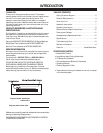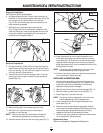
10
SERVICING DOUBLE INSULATED UNITS
This unit is double-insulated. In a double-insulated unit, two
systems of insulation are provided instead of grounding.
There is no grounding provided and no means of grounding
should be added to this unit.
Extreme care and knowledge of the system is required when
servicing a double-insulated unit. Service should be
performed by qualified service personnel only. Replacement
parts for a double-insulated unit must be identical to the
parts they replace. Refer any repair to an authorized service
dealer. A double-insulated unit is marked with the words
“double insulation” or “double insulated.”
LINE INSTALLATION
This section covers both SplitLine™ and standard single line
installation.
Always use genuine factory parts 0.065 in. (1.65 mm)
replacement line. Using line other than the specified may
make the unit overheat or fail.
There are two methods to replace the trimming line:
• Wind the inner reel with new line
• Install a prewound inner reel
Winding the Existing Inner Reel
1. Hold the outer spool with one hand and unscrew the
bump knob counterclockwise (Fig. 10). Inspect the bolt
inside the bump knob to make sure it moves freely.
Replace the bump knob if damaged.
2. Remove the inner reel from the outer spool (Fig. 11).
3. Remove spring from the inner reel (Fig. 11).
4. Use a clean cloth to clean the inner reel, spring, shaft, and
inner surface of the outer spool.
5. Check the indexing teeth on the inner reel and outer
spool for wear (Fig. 12). If necessary, remove burrs or
replace the reel and spool.
Bump Knob
Bolt
Loop
NOTE: SplitLine™ can only be used with the inner reel
with the slotted holes. Single line can be used
on either type of inner reel. Use Figure 13 to
identify the inner reel you have.
NOTE: Always use the correct line length when
installing trimming line on the unit. The line may
not release properly if the line is too long.
Inner Reel
Spring
Outer Spool
Indexing Teeth
Slotted Holes
For Use with SplitLine™
or Single Line
For Use with
Single Line ONLY
WARNING: Never use metal-reinforced line,
wire, chain or rope. These can break off and
become dangerous projectiles.
Fig. 14
Fig. 13
Fig. 12
Fig. 11
Fig. 10
MAINTENANCE & REPAIR INSTRUCTIONS


















